Early Olympus Teleconverter Lenses
Ching-Kuang Shene
Created: March 12, 2007
Updated: July 5, 2007

Updated: July 5, 2007
This page provides a summary of some older Olympus teleconverter lenses. These lenses were made for Olympus ZLR (i.e. Zoom Lens Reflex) cameras. A ZLR camera is a single lens reflex camera with a non-interchangeable zoom lens. Focal length of these cameras usually goes from 35mm to 105mm or 135mm, and some may even reach 180mm. There are five series, the A series, B series, C series, D series, and E series. Lens markings look like C-180 and B-28, where the number after the C or B gives the maximum or minimum combined focal length of the supported cameras. But, the D series and E series lenses use lens power rather than the combined focal length. Newer Olympus converter lenses use TCON-xxY and WCON-xxY markings, where xx indicates lens power such as TCON-14 and WCON-08, and Y usually indicates what camera or cameras can use that lens. For example, the C in TCON-30C means this lens uses bayonet mount, and the B in WCON-08B means this lens is for Olympus E-10 and E-20 cameras. There is a 1.5X teleconverter made for the Olympus AZ-4 camera before the IS era. This teleconverter is not part of the above mentioned series lenses.
Here is a brief list of Olympus teleconverter lenses prior to the TCON era:
Olympus and Ricoh jointly designed the Ricoh Mirai and Olympus AZ-4 ZLR cameras in the late 1980's. Both cameras are almost identical, cosmetically and functionally. Both cameras have a matching 1.5X teleconverter. The Ricoh version is the well-known and highly regarded TC-200M and the Olympus version looks identical to the TC-200M as shown in the left image below. The Ricoh version has a clear lens marking TC-200M, while this Olympus only has TELECONVERTER LENS X1.5. The right image shows this lens on a Panasonic FZ-30 with the help of a 55-52 step-down ring.
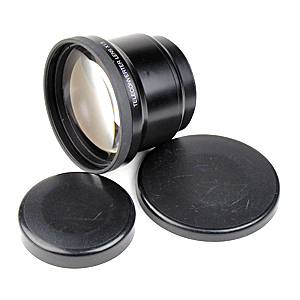
|
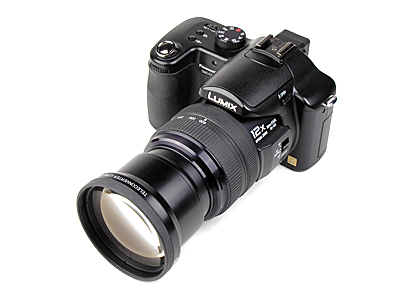
|
This is a very rare item and does not surface frequently even on eBay. Since it is nearly identical to the Ricoh, please refer to the Ricoh TC-200M for more details and a discussion of the Ricoh Mirai and Olympus AZ-4 cameras.
The first Olympus successful ZLR camera is the IS-1 (or L-1 in Japan). The IS-1 has two converters, the A-200 1.5X teleconverter and the A-28 0.8X wide angle converter. The IS-1 has a focal length range of 35mm and 135mm, and the A-200 extends the tele end to 200mm. Since the IS-1 lens has a 49mm thread, the A-200 has a 49mm mounting thread and a 55-49 step-down ring is needed to be used on a FZ-30. The left image below shows a A-200 and the right one has a A-200 on a Panasonic FZ-30 with the help of a 55-49 step-down ring.
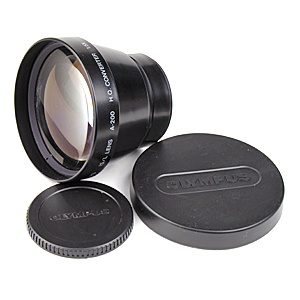
|
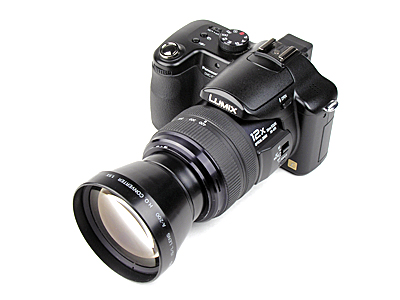
|
Since the IS-1 appeared just a few years after the Olympus AZ-4, it is natural to speculate if the A-200 and the earlier Olympus 1.5X lens are the same. Cosmetically, they are not the same as shown below. The A-200 is slightly longer; however, it is due to the length of the top tube section. Looking into the way of mounting glass elements, these two are nearly identical. However, there is a strong evidence suggesting that they are not the same. The A-200 has a slightly concave rear surface while those of the Olympus 1.5X and Ricoh TC-200M are very flat. Moreover, the reflection patterns on the rear surface from A-200 and Ricoh TC-200M are very different. Therefore, I would personally believe the A-200 and Ricoh TC-200M (and Olympus 1.5X) are similar in the front portion and have slightly different rear portion to accommodate different cameras (i.e., IS-1 vs. Mirai/AZ-4).
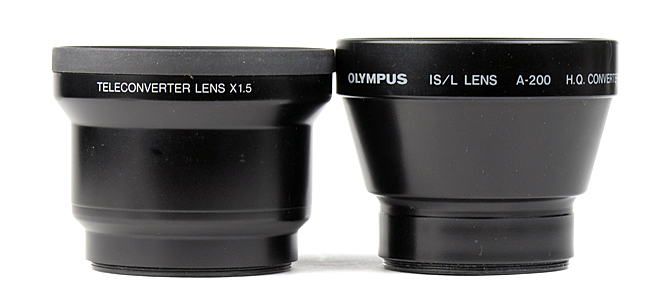
|
| Left: Early Olympus 1.5X Right: Olympus A-200 1.5X |
The B series has only one teleconverter lens, the highly regarded B-300 1.7X. Since the B-300 has a 55mm thread, no step ring is needed. The left image below shows a B-300 and the right one has a B-300 on a Panasonic FZ-30.
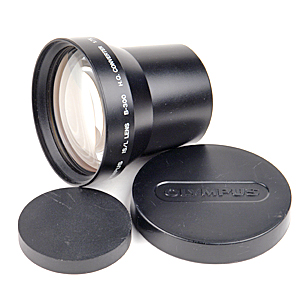
|
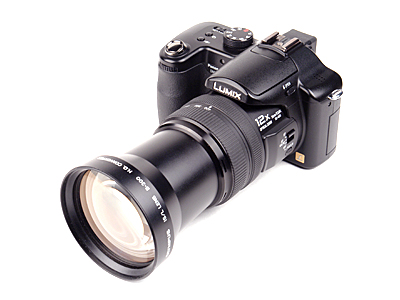
|
The B-300 is marked as IS/L LENS B-300 H.Q. CONVERTER 1.7X while the similar TCON-17 1.7X has 1.7X TELE CONVERSION LENS. Other than the different lens markings, they look incredibly similar as shown in the image below, and, as a result, many people consider the B-300 and TCON-17 as the same lens with different names. Frankly, I personally do not have any evidence to support or deny this speculation.
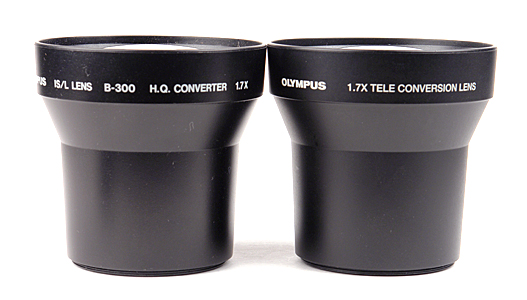
Both the C-180 and C-210 come with a front cap and a rear cap. Both lenses have a rear thread size of 52mm and have no front thread. The images on the top row below show an Olympus C-180 and a C-180 on a FZ-30 with a 55-52mm step-down ring. The images on the bottom row below show an Olympus C-210 and a C-210 on a FZ-30. Again, a 55-52mm step-down is required.
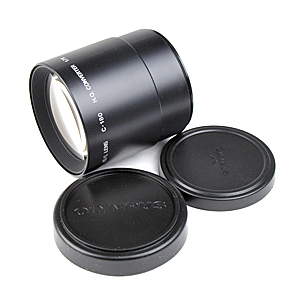
|
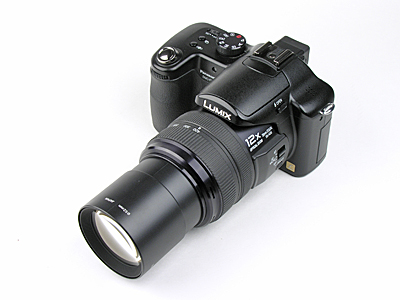
|
| Olympus C-180 1.7X | |
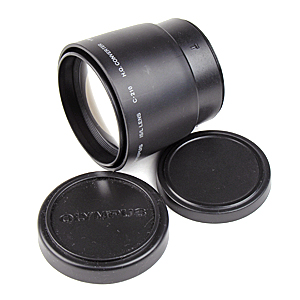
|

|
| Olympus C-210 1.9X | |
The C-210 has a retractable lens hood. The above images have the lens hood retracted, and the left image below has the lens hood fully extended. Although both lenses have a rear thread of 52mm, the rear element is small with a diameter approximately 18mm. See the right image below. As a result, vignetting is unavoidable.
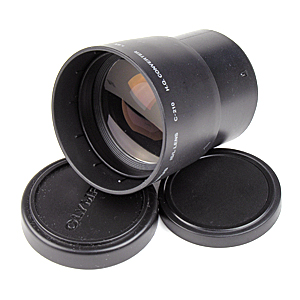
|
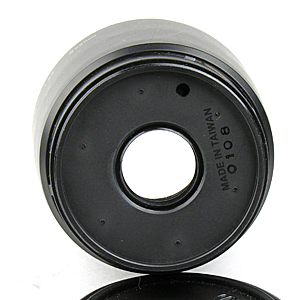
|
Both lenses are plastic and very light; however, whether the lens elements are also plastic is unknown.
The following tables are assembled from the instruction sheets of the lenses or by direct measurement; however, some of the length and weight values are only approximation. Moreover, the calculated maximum combined focal length entries are based on the Panasonic FZ-30. For other cameras, just multiply the maximum focal length of the camera lens and the lens power of the teleconverter.
| Item | Olympus 1.5X | Olympus A-200 | Olympus B-300 |
| Number of lenses |
|
4 elements in 2 groups | 5 elements in 3 groups |
| Magnification | 1.5X | 1.5X | 1.7X |
| Combined focal length | 630mm | 630mm | 714mm |
| Rear Thread Size | 52mm | 49mm | 55mm |
| Front Thread Size | none | none | none |
| Size | 57mm (L) × 73mm (W) | 58mm (L) × 73.5mm (W) | 74.5mm (L) × 80mm (W) |
| Weight | 200g (7.1 oz) | 160g (5.6 oz) | 260g |
| Item | Olympus C-160 | Olympus C-180 | Olympus C-210 |
| Number of lenses | 3 elements in 2 groups | 4 elements in 2 groups | 4 elements in 2 groups |
| Magnification | 1.45X | 1.7X | 1.9X |
| Combined focal length | 609mm | 714mm | 798mm |
| Rear Thread Size | 52mm | 52mm | 52mm |
| Front Thread Size | none | none | none |
| Size | 60mm (L) × 57mm (W) | 58mm (L) × 56mm (W) |
Lens Hood Retracted: 61mm (L) × 64.5mm (W) Lens Hood Extended: 75mm (L) × 64.5mm |
| Weight | 85g (3 oz) |
80g (2.8 oz) |
125g (4.4 oz) |
| Item | Olympus D-1.45X | Olympus E-1.3X |
| Number of lenses | 3 elements in 2 groups | 3 elements in 2 groups |
| Magnification | 1.45X | 1.3X |
| Combined focal length | 609mm | 546mm |
| Rear Thread Size | clip-on | 52mm |
| Front Thread Size | none | none |
| Size | 39mm (L) × 61mm (W) | 45mm (L) × 74.5mm (W) |
| Weight | 105g | 125g (4.4 oz) |
As mentioned earlier, a 55-52mm step-down ring is required to mount the C-180, C-210 and Olympus 1.5X (or Ricoh TC-200M) on a Panasonic FZ-30, and a 55-49mm step-down ring is required for the A-200 1.5X. Due to small rear elements, the use of a thinner ring is recommended because a thinner ring produces less vignetting than a thicker ring does. Once the lens is mounted on the camera, one can start shooting immediately, and does not have to set the camera to the Telephoto mode. As a result, there is nothing special with respect to using this lens.
Light fall-off (i.e., the corners being darker than the center) is likely unavoidable with most teleconverters. The following images were taken with a FZ-30 and A-200, B-300, C-180 and C-210. Light fall-off of the A-200 and B-300 is minimal. It is clear that the C-180 and C-210 both exhibit a similar pattern of light fall-off or vignetting. This is usually not a very serious problem because in normal shooting darker corners can actually make the center portion standing out. However, if the scene is uniformly illuminated (e.g., the sky), vignetting can be very clear.

|

|
| Olympus A-200 | Olympus B-300 | 
|

|
| Olympus C-180 | Olympus C-210 |
As for light loss, a spot light meter was used to measure through the center of the lens. The A-200 has a difference of 0.1 to 0.2 EV on average, while the the B-300 has 0.2 to 0.3 EV. Hence, one may ignore this difference when using a A-200 or B-300. The measured difference of C-180 and C-210 can be as high as 1.2 EV, one stop to 1 1/3 stop exposure compensation may be needed when using these lenses.
The minimum working distance is the shortest distance measured from the front of the lens to the subject that the lens focuses on. In general, the minimum working distance of a converter lens is proportional to the square of the converter lens power being used. This distance is also affected by the minimum focus distance of the camera lens, and hence different cameras will have different minimum working distance even with the same converter lens. The measured working distances of the A-200, B-300, C-180 and C-210 with a Panasonic FZ-30 at 420mm (i.e., the maximum focal length) are shown below. Note that these measured values are approximations rather than exact values.
| Lens | A-200 | B-300 | C-180 | C-210 |
| Minimum Working Distance | 2.8m (111 in) | 4.2m (165 in) | 3.8m (150 in) | 6.1m (242 in) |